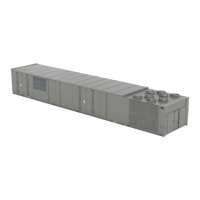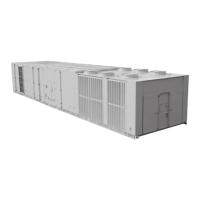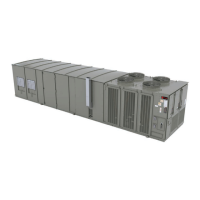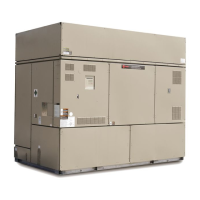RT-SVX073A-EN
75
cooling when heat capacity is no longer required. Supply
Air Tempering is disabled by default.
Multi Zone-VAV equipment allows supply air tempering
when equipped with Modulating Gas, Ultra Modulating
Gas, and SCR Electric Heat. Constant Volume – Discharge
Air Temperature equipment allow all forms of heating to
provide supply air tempering.
Changeover Input
Multi Zone-VAV and Constant Volume Discharge
Temperature units configured with heat include a binary
Changeover Input. An open input requests discharge air
cooling operation. A closed input will change over to
discharge air heating. This local input is arbitrated with
building management Heat Cool Mode Request commands
to determine the active mode of operation.
VAV Box Relay Output
This binary output is provided by the controller to be
optionally wired to VAV units in a Multi Zone-VAV system to
coordinate system changeover to full airflow heating. The
binary output is de-energized when the controller is
operating in cooling modes. The binary output energizes
when the heat type installed requires full airflow. See
Maximum Heat for more details.
Discharge Air Reset
Discharge Air Reset is a method to save energy by
resetting the discharge air temperature as heating and
cooling building loads increase and decrease.
When enabled, the controller can independently reset the
Discharge Air Heating Setpoint Active and/or Discharge Air
Cooling Setpoint Active based on Zone (space
temperature) or Outdoor Air temperature. The new target
setpoints are reported as Discharge Air Setpoint Heating
Status and Discharge Air Cooling Setpoint Status.
The user interface display provides settings for the reset
temperature range (Zone or Outdoor Air) and discharge air
temperature setpoint reset amount over the specified
range. For example: the discharge air temperature cooling
setpoint shall increase 5°F over an outdoor air temperature
range of 90°F to 70°F. If Discharge Air Cooling Setpoint
Active is 50°F and Outdoor Air Temperature is 80°F, the
reset function calculates and reports Discharge Air Cooling
Setpoint Status = 52.5°F. The controller will provide
discharge air at 52.5°F.
Duct Static Pressure Control
Multi Zone-VAV equipment have variable speed supply
fans and are often used in Variable Air Volume (VAV)
systems consisting of ductwork serving multiple building
zones and VAV boxes that control space comfort
independent of the rooftop air handler. VAV boxes
modulate air volume by a damper that opens and closes to
maintain space comfort. In response, duct static pressure
increases and decreases. The controller will modulate
supply fan speed to maintain Duct Static Pressure relative
to the Duct Static Pressure Setpoint
Duct Static Pressure High Limit
The controller operates the supply fan to maintain duct
static pressure below the Duct Static Pressure High Limit
setpoint. In the event that duct static pressure approaches
the high limit setpoint, the controller will reduce and limit
the supply fan speed.
Space Temperature Control
Space Temperature Control uses available heating and
cooling to deliver comfort to a building space. The control
requires a valid space temperature and discharge air
sensor value; if either input to the control is invalid, the
equipment cannot operate.
Space Temperature Control determines the type of load
(heating or cooling) in the space based on active cooling
and heating setpoints and space temperature. If space
temperature is above the cooling setpoint, this represents a
space-cooling load. The control will calculate a Discharge
Air Temperature Setpoint to satisfy the cooling demand of
the space.
The relationship of the calculated discharge air setpoint
and discharge air temperature will drive heating and
cooling capacity available to satisfy the discharge air
temperature setpoint. For Example: As space temperature
cooling load increases, space temperature control will
calculate a lower Discharge Air Temperature setpoint and
therefore will increase cooling capacity. The calculated
discharge air cooling setpoint is bound by Discharge Air
Temperature Maximum Cool Limit and Discharge Air
Temperature Minimum Cool Limit.
If heat-cool mode input is either not provided or
unsupported the mode input is Auto. The controller will
automatically determine the appropriate heat or cool mode
of operation based on space temperature, setpoints, and
heating/cooling configured for the unit. Heat or Cool is
reported by Heat Cool Mode Status.
Auto Changeover
When the controller input mode of operation is Auto, the
controller will automatically determine space heating and
cooling mode, the unit changes from cool to heat or from
heat to cool, when the integrated error between the space
setpoint and space temperature is 900°F-seconds or
greater. The integrated error is calculated once every 10
seconds. See figure below for an example of changing
from space cooling to space heating. If Cool is the active
mode and space temperature is less than 1°F below the
active heating setpoint the system will immediately change
to Heat mode. If space temperature is greater than 1°F
above the active cooling setpoint, the mode to change to
Cool.
Space Dehumidification is a Cool mode sequence of
operation if the unit is equipped with hot gas reheat. A unit
that has a dehumidification demand will switch from Heat
mode to Cool mode if heating capacity is off and space
temperature is above the heating setpoint. A unit operating
in dehumidification control will inhibit the normal mode
transition from Cool mode to Heat mode.
Unit Startup

